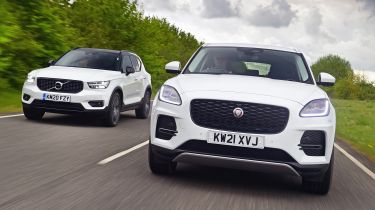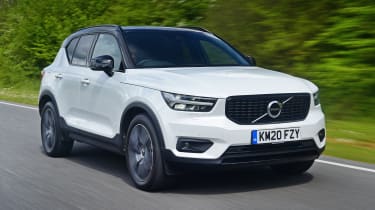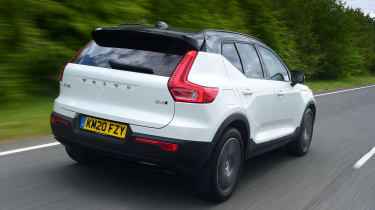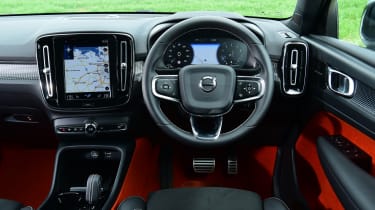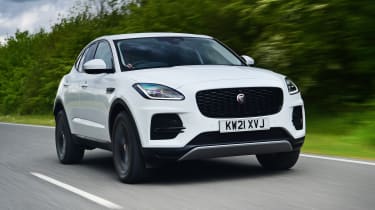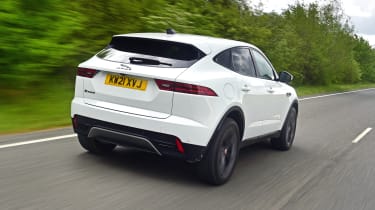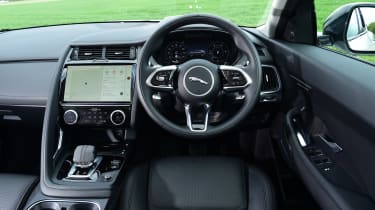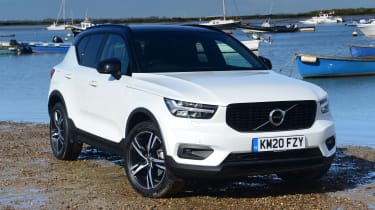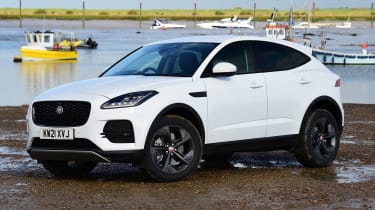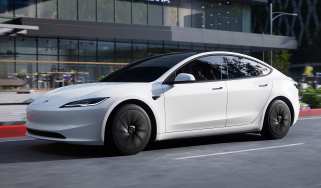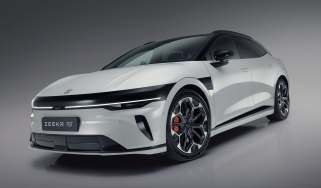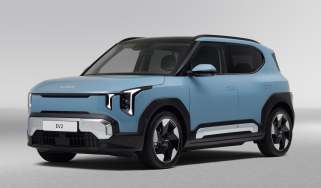Volvo XC40 vs Jaguar E-Pace: 2022 twin test review
The Volvo XC40 and Jaguar E-Pace go head-to-head in this small premium SUV battle
Imagine you have about £40,000 to spend on a stylish SUV. Trouble is, none of the typical German offerings really float your boat and you’d prefer something a little different. The good news is that there are two very compelling alternatives to the likes of an Audi Q3 and BMW X1, and both are rather easy on the eye.
From the outside, the Jaguar E-Pace could never be mistaken for anything other than a Jaguar, and like the rest of the British brand’s line-up, it has the look of a car that’s styled to be one of the more dynamic and driver-focused options in the class. This is our first test of the facelifted model; among the changes is the brand’s Pivi Pro infotainment system.
The Volvo XC40 is no less distinctive inside or out, and like the Jaguar, it’s a breath of fresh air beside the more predictable offerings in the segment.
Both of these cars are available with four-wheel drive, helping to back up their off-road looks with potential for coping with slightly slippery terrain. But which should you choose? Will the revisions to the Jaguar help it sail away with the win, or will the Volvo anchor itself to the top spot?
Volvo XC40
| Model: | Volvo XC40 B4 P AWD Plus |
| Price: | £40,000 |
| Engine: | 2.0-litre 4cyl petrol mild-hybrid |
| Power/torque: | 194bhp/300Nm |
| Transmission: | Seven-speed automatic, four-wheel drive |
| 0-62mph/top speed: | 7.6 seconds/112mph |
| WLTP economy: | 34.0 mpg/7.5mpl |
| CO2/tax: | 161g/km/£145 |
| Options: | Premium metallic paint (£850), spare wheel and jack (£150) |
It might be a left-field choice, but the Volvo XC40 ranks among the most popular compact SUVs. No doubt helped by the availability of PHEV and fully electric powertrains, the XC40 broke into the top 10 best-selling cars in the UK in December 2021, according to SMMT data.
Used - available now
Here, we’re trying a mild-hybrid. Volvo previously offered a diesel, which was a close match to the E-Pace for output, but this is the B4 petrol and, as with the Jag, it has all-wheel drive. A 161bhp, front-wheel- drive B3 P is also available. A recent XC40 trim structure overhaul has changed the names, so while the car seen here is an R Design (some of which are still in stock), we’re testing the XC40 as the Plus model.
The XC40 cuts a unique figure in Volvo’s line-up. While most of the firm’s range focuses on understated cool for their aesthetic, the brand’s smallest SUV instead chooses bold, dramatic lines and an overall profile that looks almost boxy beside many rivals, and especially the Jaguar. The resulting look is funky and modern in the metal, especially when combined with the contrasting black roof and door mirrors of our test car.
It’s a shame some of the design flourishes bring compromises, though; the kink towards the rear of the side windows looks dramatic from the outside, but it means that the driver has to put up with poor over-the-shoulder visibility.
Overall, the cabin looks fabulous and has smart touches. The sweeping, part-carpeted door panels feature a large cutout across their lower edges, which means that the door bins are absolutely huge. There’s a removable waste bin between the front seats, while the central storage cubby behind it is very deep. The glovebox is quite small, though.
Volvo’s Compact Modular Architecture, also used by the Polestar 2, forms the basis of the XC40’s structure, and is able to accommodate combustion, plug-in hybrid and pure-electric powertrains. At the more affordable end of the range sit a couple of mild-hybrid petrol versions.
The latest Volvos feature a Google-based infotainment system. It includes the use of online services and quick loading times, but it’s not without its flaws. The portrait display has tiny on-screen keys for many of the functions, which makes it hard to make small adjustments. A small bar along the bottom expands to present the climate controls. Putting these settings on screen might make the cabin appear less cluttered than the E-Pace’s, but it also takes more getting used to.
Out on the road, the Volvo’s ride is relatively soft. For the most part, it’s a comfortable and relaxing car to drive, but on the 19-inch wheels of this test model, there was some low-speed fidgeting.
The XC40’s more forgiving suspension set-up means that there’s slightly more body roll than you’ll find in its rival from Jaguar, but that’s more than offset by how much keener and lighter the Swedish SUV feels through the turns.
When it comes to running costs for private buyers, the Volvo has a key advantage. Over three years, the XC40 will hold on to almost 60 per cent of its original value, while the Jaguar will maintain 55.6 per cent. That means the Swedish model will lose £16,025 of its original price in that time, while the E-Pace will shed £980 more.
Touchscreen
The only physical switch for the infotainment system is a home button. We’d like more because the various on screen icons are small and fiddly
Instruments
Digital dials ape those of Volvo’s old analogue clocks; they’re easy to read, but the resolution could be sharper
Build quality
Parts you often touch, such as the door handles and air vents, feel sturdy
Jaguar E-Pace
| Model: | Jaguar E-Pace D165 AWD S |
| Price: | £38,255 |
| Engine: | 2.0-litre 4cyl diesel mild-hybrid |
| Power/torque: | 161bhp/380Nm |
| Transmission: | Eight-speed automatic, four-wheel drive |
| 0-62mph/top speed: | 9.8 seconds/124mph |
| WLTP economy: | 43.3mpg/9.5mpl |
| CO2/tax: | 171g/km/£145 |
| Options: | Exterior Black Pack (£500), Technology Pack (£1,580), electric front seats (£350), Meridian sound system (£600), heated steering wheel (£205), privacy glass (£370) |
As with the XC40, the E-Pace is the baby of Jaguar’s SUV line-up, and 2021 saw the model given a host of mid-life upgrades. These included tweaked bumpers, a revised grille and new LED lighting graphics, while the inside received extra soft-touch materials and a reprofiled transmission tunnel to improve front legroom.
Here we’re testing it in the base S trim, powered by a 2.0-litre diesel engine with 161bhp, which is backed up by a hefty 380Nm of torque. The range tops out with the P300e, a 309bhp plug-in hybrid that pairs a 1.5-litre turbo petrol engine with an electric motor. Unlike the Volvo, there isn’t a fully electric version to choose from.
While the E-Pace sports a much sleeker, curvier shape than the deliberately upright Volvo, the Jaguar takes up a very similar amount of space on the road; it’s just 14mm shorter, 10mm narrower and 9mm lower than its Swedish rival.
Those similar external dimensions translate into two cars which offer similar rear-seat space. The Jag is a match for the Volvo in terms of kneeroom, although the XC40 has a little more foot space under the front seats. However, the Jaguar’s centre seat is more comfortable, and the central hump in the floor is lower, so overall the E-Pace is better at accommodating three people.
The most significant change among the mid-life updates comes in the form of Jaguar’s latest Pivi Pro infotainment set-up. Not only is the 11.4-inch screen much larger than before, but loading and touch times are also rapid. The graphics look fantastic, and the landscape orientation integrates brilliantly, with smartphone apps such as Apple CarPlay and Android Auto expanding to fit the full display.
Despite that huge screen, Jaguar has kept big, physical controls for the air-conditioning. Each of the dials serves several purposes; by pushing them in or pulling them out, it switches their use from temperature, to fan speed, to adjusting the seat heating. It’s much more intuitive to operate than the touchscreen climate controls of the Volvo.
Under the skin, the E-Pace shares its platform with the Range Rover Evoque and Land Rover Discovery Sport, and beside the Volvo, its 1,916 kerbweight makes it heavier by the tune of 244kg. To illustrate how chunky it is, that figure is only 35kg lighter than its big brother, the F-Pace, when equipped with an identical diesel engine.
While much of Jaguar’s current line-up challenges the class leaders when it comes to ride and handling, the E-Pace goes against that trend. Aim towards a series of corners and it feels slow and lazy to change direction. There’s not much trade-off in terms of refinement, either. For the most part, the Jaguar rides more firmly than the Volvo, although the E-Pace is more settled at low speeds. Road roar is better contained, though.
Despite the on-paper performance and weight disadvantage to the XC40, the E-Pace doesn’t feel
as sluggish in a straight line as you might expect. That’s thanks to the diesel engine’s heavy dose of torque; its 380Nm maximum is 80Nm more than its rival and it arrives from just 1,500rpm. Unless you’re mashing your right foot into the bulkhead away from a set of traffic lights, the Jaguar makes fairly easy, relaxing progress.
Heated windscreen
Tiny heating elements in the front window help the E-Pace to defrost quickly on cold mornings
Materials
Steering wheel is lovely to hold, and chromed gearshift paddles feel fantastic
Digital dials
Jaguar’s 12.3-inch display looks great. Its resolution appears much higher than fuzzy Volvo display
Verdict
First place: Volvo XC40
There's little to choose between these two, but the Volvo takes the win by a slim margin. It’s more roomy than the Jaguar, it’s safer, and should be a more satisfying ownership prospect. It’s also much more enjoyable to drive than the Jag, but they are closely matched in terms of comfort.
Second place: Jaguar E-Pace
For those SUV buyers who consider in-car tech as the biggest deal-breaker, the E-Pace deserves to be right at the top of any shortlist. It’s comfy and spacious, so it’ll cover the practical demands of most people. But it’s dull to drive, and its heavy weight means unremarkable running costs.
